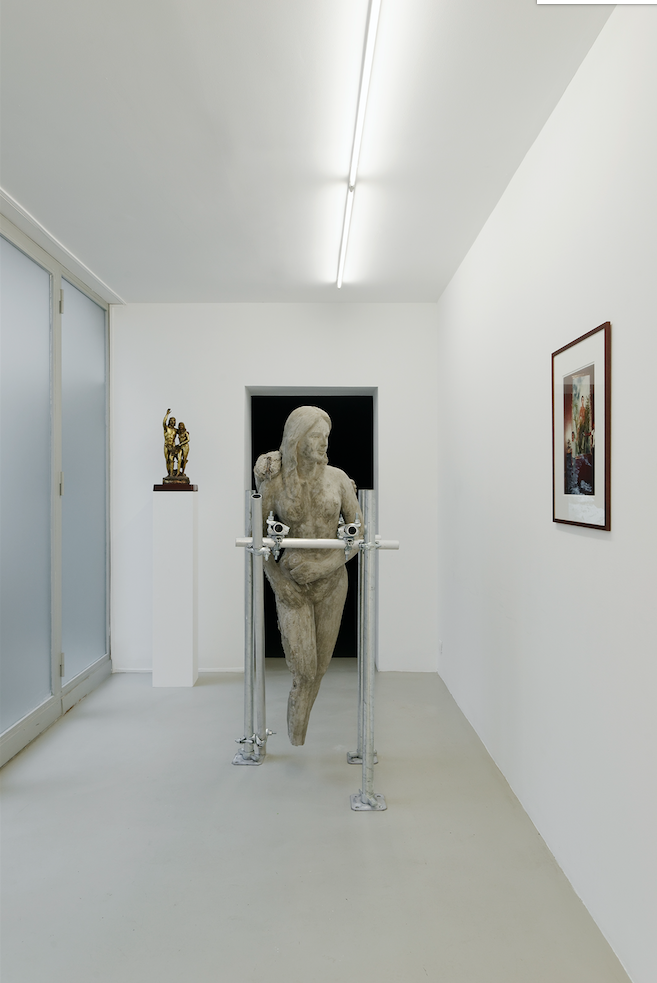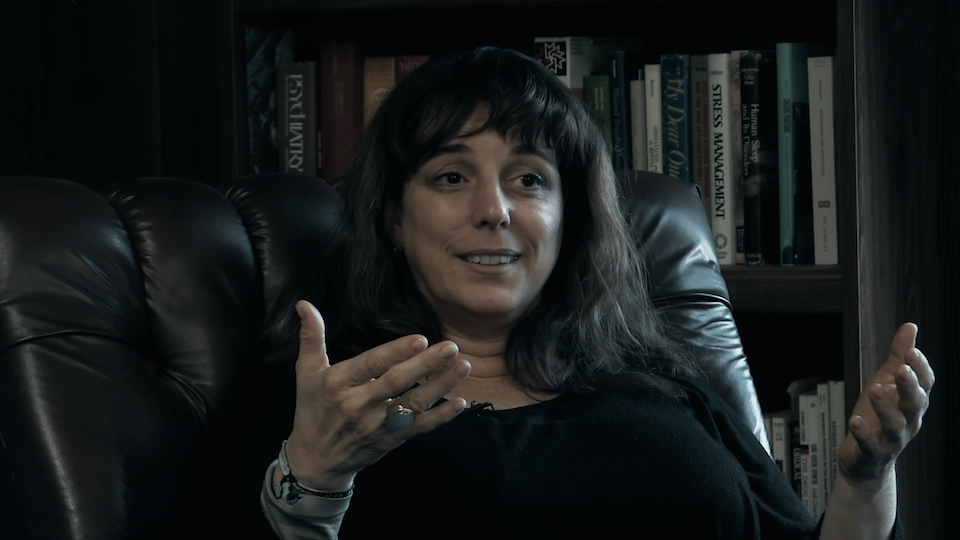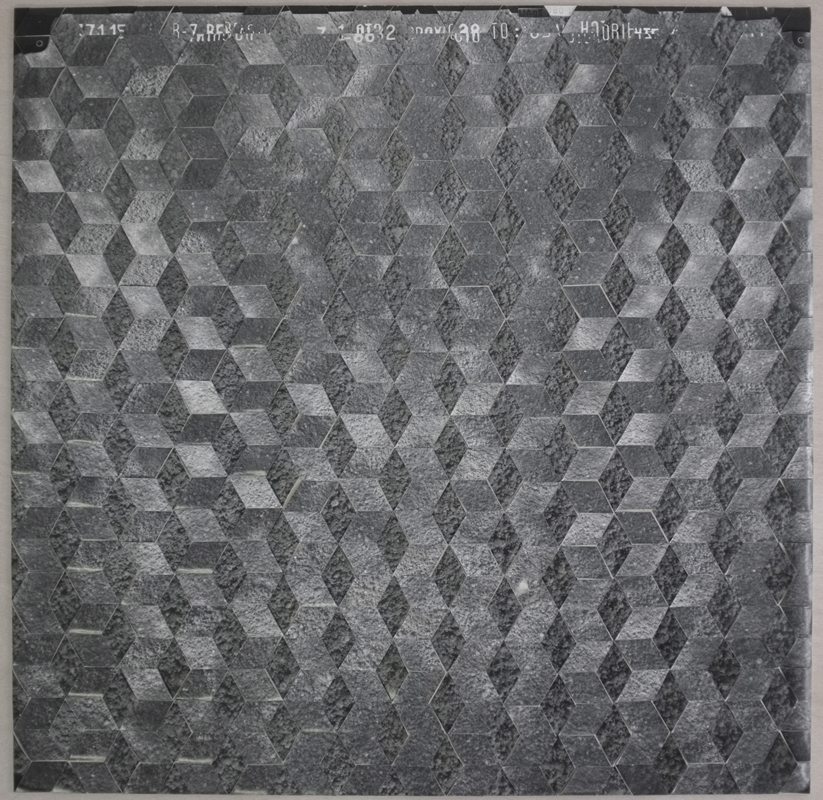
© » KADIST
Fredi Casco
Drawing & Print (Drawing & Print)
Pascua Dolorosa (Painful Easter) by Fredi Casco is a series of drawings made on old worksheets documenting land surfaces in Caapucú, a forest exploitation area where one of the most violent episodes of the repression of Stroessner’s dictatorship took place in 1976, and during which peasants accused of belonging to insurgent movements were kidnapped, tortured and many of them killed. In 2009, human bone remains were found in the Caapucú region during ground measurement work. These works reveal the tension between a cold and positivistic approach to landscape as put on record in the legal papers, the poignant use of violence as inscribed into the land, and a ghostly invocation of the power of resistance.

© » KADIST
Rometti Costales
Canción para un fósil canoro (Song for a chanting fossil) by Rometti Costales is inspired by the history of the building that currently hosts the Museo de la Solidaridad Salvador Allende (MSSA) in Santiago, Chile. The duo associated the layers of the building’s history with the vestiges of life and the processes of fossilization that have taken place in areas of the Atacama Desert, a territory that has been the stage for several episodes in Chile’s tumultuous economic and political history. The work operates as a metaphor for the strata of historical memory, condensing different materials and operations.

© » KADIST
Cristóbal Lehyt
Drawing & Print (Drawing & Print)
Cristóbal Lehyt has conducted thorough research on the historical and cultural complexity of the northern region of Chile where the Atacama Desert is located. This area, rich both in terms of its cultural heritage and its natural resources (such as the copper mines), is at the origins of some of the most dramatic episodes in the country’s recent political history. With the series Untitled (Given a wall, what’s happening behind it?)

© » KADIST
Ciprian Muresan
Forgotten Statues , 2020 continues the artist’s reflections on power and the fragility of works of art. In this case, it’s no longer about sculptures which are no longer on display but rather those that are on permanent display, fixing the official narrative of art history. In Forgotten Statues , the artist reproduces from memory sculptures from the permanent exhibition of the Art Museum in Cluj.

© » KADIST
Tamar Guimarães
Canoas by Tamar Guimarães is a film made for the 2010 São Paulo biennial as an exercise in the projection of national identity. The main subject and setting of the film is Casa das Canoas, the home that architect Oscar Niemeyer built for himself in the early 1950s. Overlooking the bay on the outskirts of Rio de Janeiro, the building has achieved iconic status in Brazil.

© » KADIST
Arseny Zhilyaev
His large installation entitled The Museum of Proletarian Culture (2012) looked at the changes in artistic practice that have occurred in Russia throughout the last thirty years – from the amateur art of the late Soviet era to the commercialized post-Soviet cultural practices and the more recent self-expression via contemporary social networks. Thus, the exhibition becomes a whole installation where it is impossible to distinguish architecture from assemblage, facts from fantasy, document from fiction. It is a museum of museums where viewers find themselves in the era of didactic exhibitions; whereby the main protagonists are workers, engineers, and amateur artists, and finally replaced by the creative class of 1990s and 2000s.

© » KADIST
Pio Abad
Comprising two sculptures, one photograph and one video, the installation Malakas & Maganda (1986 – 2016) questions the mythological iconography of the Filipino conjugal dictators Ferdinand and Imelda Marcos and thus addresses the construction of propaganda representation and the role of art facing current events. The work is organized around the leftovers of a copy of a monumental sculpture of Imelda Marcos, which the artist had commissioned and whose remains were stored in his studio. Several included elements show how this body of work has evolved over time and in reaction to political events in the Philippines.

© » KADIST
Leung Chi Wo and Wong Sara
Photojournalist with Two Cameras restages a portrait of a photojournalist from the background of an old photograph of protest published in South China Morning Post on January 10, 2010 under the headline “Return of the Radicals: Recent angry protests are nothing new.” The photojournalist in the photograph, probably from a protest of earlier decades, was capturing the scene of a protester’s arrest while wearing two cameras. January of 2010 was a time of pro-Democracy demonstrators called for the release of activist Liu Xiaobo, drafter of the Charter 08 manifesto calling for the end of authoritarian rule, was sentenced to 11 years in prison one month earlier. Leung’s isolating and highlighting of the photographer by bringing him from the original photograph’s background to the foreground of his studio shot calls attention to the two older cameras and the journalist’s retro-style clothing.

© » KADIST
Amalia Pica
Memorial for intersections #2 (2013) is a minimalist, black metallic structure that contains the brightly colored translucent circles, triangles, rectangles, and squares that originally were presented in Pica’s performance work A ? B ? C (2013).

© » KADIST
Lynn Hershman Leeson
Tania Libre is a film by Lynn Hershman Leeson centered around renowned artist Tania Bruguera and her experience as a political artist and activist under the repressive government of her native Cuba. The film begins with the voice of Tilda Swinton narrating a manifesto of artists’ rights written by Bruguera in which she expresses her views on art, our universal right to both enjoy and create art, and the duty that artists have to dissent. The film then captures a series of therapy sessions between Bruguera and Dr. Frank M. Ochberg—the founding father of trauma therapy, particularly PTSD and Stockholm Syndrome—where Bruguera describes with great candor and earnestness several traumatic experiences such as the betrayal by her father who handed her to Cuban secret service, and her imprisonment in Havana years later after advocating for freedom of expression.
Ciprian Muresan
Ciprian Muresan appropriates historical, political, social and cultural (essentially artistic, literary and cinematographic) references which he re-contextualizes...
Lynn Hershman Leeson
- location: San Francisco, California
- year born: 1941
- gender: female
- nationality: American
- home town: Cleveland, Ohio
Arseny Zhilyaev
Arseny Zhilyaev is arguably one of the most influential contemporary Russian artists of his generation...
Leung Chi Wo and Wong Sara
Leung Chi Wo tends to highlight in his art the boundaries between viewing and voyeurism, real and fictional, and art and the everyday...
Rometti Costales
Rometti Costales is an artistic collaboration between Julia Rometti and Victor Costales that began in 2007...
Amalia Pica
- location: London, United Kingdom
- year born: 1978
- gender: female
- nationality: Argentine
- home town: Neuquén, Argentina
Fredi Casco
Working with a variety of media such as drawing, painting and photography Fredi Casco frequently incorporates original documents and archives as a medium and support of his work in order to bring to light specific episodes of Paraguayan political history, particularly events that took place during the time of Alfredo Stroessner’s long dictatorship (1954 to 1989)...
Pio Abad
In his practice, Pio Abad looks into the social and political significance of objects usually consigned to the sidelines of history...
-
2010-2019
Tamar Guimarães
2010Canoas by Tamar Guimarães is a film made for the 2010 São Paulo biennial as an exercise in the projection of national identity...
Leung Chi Wo and Wong Sara
2010Photojournalist with Two Cameras restages a portrait of a photojournalist from the background of an old photograph of protest published in South China Morning Post on January 10, 2010 under the headline “Return of the Radicals: Recent angry protests are nothing new.” The photojournalist in the photograph, probably from a protest of earlier decades, was capturing the scene of a protester’s arrest while wearing two cameras...
Amalia Pica
2013Memorial for intersections #2 (2013) is a minimalist, black metallic structure that contains the brightly colored translucent circles, triangles, rectangles, and squares that originally were presented in Pica’s performance work A ? B ? C (2013)...
Cristóbal Lehyt
Drawing & Print
2016(Drawing & Print) Cristóbal Lehyt has conducted thorough research on the historical and cultural complexity of the northern region of Chile where the Atacama Desert is located...
Lynn Hershman Leeson
2016Tania Libre is a film by Lynn Hershman Leeson centered around renowned artist Tania Bruguera and her experience as a political artist and activist under the repressive government of her native Cuba...
Fredi Casco
Drawing & Print
2017(Drawing & Print) Pascua Dolorosa (Painful Easter) by Fredi Casco is a series of drawings made on old worksheets documenting land surfaces in Caapucú, a forest exploitation area where one of the most violent episodes of the repression of Stroessner’s dictatorship took place in 1976, and during which peasants accused of belonging to insurgent movements were kidnapped, tortured and many of them killed...
Pio Abad
2017Comprising two sculptures, one photograph and one video, the installation Malakas & Maganda (1986 – 2016) questions the mythological iconography of the Filipino conjugal dictators Ferdinand and Imelda Marcos and thus addresses the construction of propaganda representation and the role of art facing current events...
Rometti Costales
2019Canción para un fósil canoro (Song for a chanting fossil) by Rometti Costales is inspired by the history of the building that currently hosts the Museo de la Solidaridad Salvador Allende (MSSA) in Santiago, Chile...
-
2020-2029
Ciprian Muresan
2020Forgotten Statues , 2020 continues the artist’s reflections on power and the fragility of works of art...








